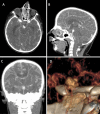Central nervous system vasculopathy and Seckel syndrome: case illustration and systematic review
- PMID: 34345934
- PMCID: PMC8604825
- DOI: 10.1007/s00381-021-05284-8
Central nervous system vasculopathy and Seckel syndrome: case illustration and systematic review
Abstract
Purpose: To systematically review reported cases of Seckel syndrome (SS) and point out cases associated with central nervous system (CNS) vasculopathy and provide a summary of their clinical presentation, management, and outcomes including our illustrative case.
Methods: We conducted a search on the MEDLINE, PubMed, Google Scholar, and Cochrane databases using the keywords "Seckel + syndrome." We identified 127 related articles reporting 252 cases of SS apart from our case. Moreover, we searched for SS cases with CNS vasculopathies from the same databases. We identified 7 related articles reporting 7 cases of CNS vasculopathies in SS patients.
Results: The overall rate of CNS vasculopathy in SS patients is 3.16% (n = 8/253), where moyamoya disease (MMD) accounted for 1.97%. The mean age is 13.5 years (6-19 years), with equal gender distribution (M:F, 1:1). The most common presenting symptoms were headache and seizure followed by weakness or coma. Aneurysms were mostly located in the basilar artery, middle cerebral artery, and internal carotid artery, respectively. Regardless of the management approach, 50% of the cases sustained mild-moderate neurological deficit, 37.5% have died, and 12.5% sustained no deficit.
Conclusion: A high index of suspicion should be maintained in (SS) patients, and MMD should be part of the differential diagnosis. Prevalence of CNS vasculopathy in SS is 3.16% with a much higher prevalence of MMD compared to the general population. Screening for cerebral vasculopathy in SS is justifiable especially in centers that have good resources. Further data are still needed to identify the most appropriate management plan in these cases.
Keywords: Bird-headed dwarfism; Cerebrovascular disorders; Intracranial aneurysm; Microcephalic osteodysplastic primordial dwarfism; Moyamoya disease; Seckel syndrome; Type II.
© 2021. The Author(s).
Conflict of interest statement
The authors declare no competing interests.
Figures






References
Publication types
MeSH terms
LinkOut - more resources
Full Text Sources
Medical

